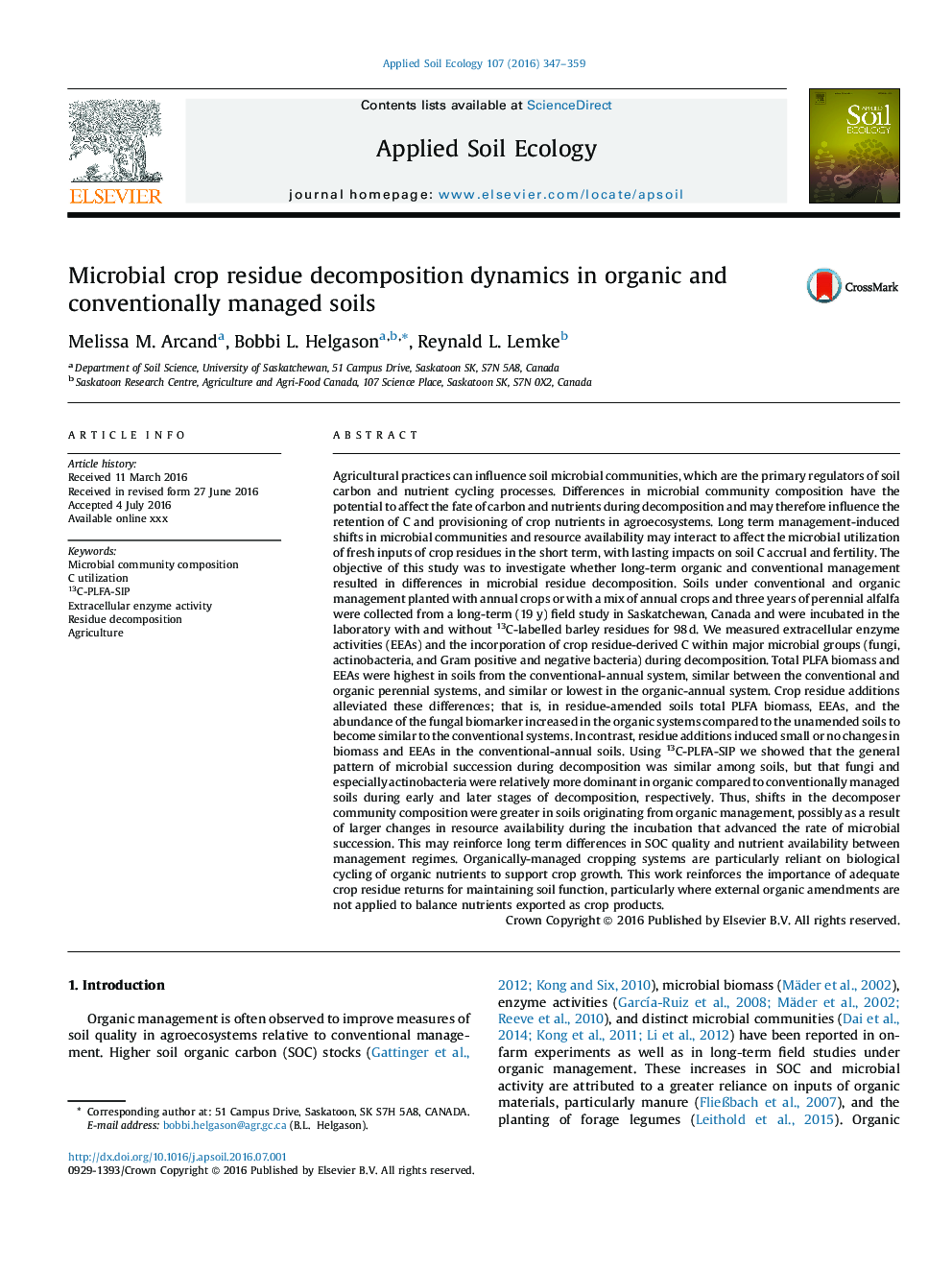| کد مقاله | کد نشریه | سال انتشار | مقاله انگلیسی | نسخه تمام متن |
|---|---|---|---|---|
| 6297659 | 1617776 | 2016 | 13 صفحه PDF | دانلود رایگان |
عنوان انگلیسی مقاله ISI
Microbial crop residue decomposition dynamics in organic and conventionally managed soils
ترجمه فارسی عنوان
تجزیه پویایی باقیمانده محصولات میکروبی در خاک های آلی و متعارف مدیریت شده
دانلود مقاله + سفارش ترجمه
دانلود مقاله ISI انگلیسی
رایگان برای ایرانیان
کلمات کلیدی
موضوعات مرتبط
علوم زیستی و بیوفناوری
علوم کشاورزی و بیولوژیک
بوم شناسی، تکامل، رفتار و سامانه شناسی
چکیده انگلیسی
Agricultural practices can influence soil microbial communities, which are the primary regulators of soil carbon and nutrient cycling processes. Differences in microbial community composition have the potential to affect the fate of carbon and nutrients during decomposition and may therefore influence the retention of C and provisioning of crop nutrients in agroecosystems. Long term management-induced shifts in microbial communities and resource availability may interact to affect the microbial utilization of fresh inputs of crop residues in the short term, with lasting impacts on soil C accrual and fertility. The objective of this study was to investigate whether long-term organic and conventional management resulted in differences in microbial residue decomposition. Soils under conventional and organic management planted with annual crops or with a mix of annual crops and three years of perennial alfalfa were collected from a long-term (19 y) field study in Saskatchewan, Canada and were incubated in the laboratory with and without 13C-labelled barley residues for 98Â d. We measured extracellular enzyme activities (EEAs) and the incorporation of crop residue-derived C within major microbial groups (fungi, actinobacteria, and Gram positive and negative bacteria) during decomposition. Total PLFA biomass and EEAs were highest in soils from the conventional-annual system, similar between the conventional and organic perennial systems, and similar or lowest in the organic-annual system. Crop residue additions alleviated these differences; that is, in residue-amended soils total PLFA biomass, EEAs, and the abundance of the fungal biomarker increased in the organic systems compared to the unamended soils to become similar to the conventional systems. In contrast, residue additions induced small or no changes in biomass and EEAs in the conventional-annual soils. Using 13C-PLFA-SIP we showed that the general pattern of microbial succession during decomposition was similar among soils, but that fungi and especially actinobacteria were relatively more dominant in organic compared to conventionally managed soils during early and later stages of decomposition, respectively. Thus, shifts in the decomposer community composition were greater in soils originating from organic management, possibly as a result of larger changes in resource availability during the incubation that advanced the rate of microbial succession. This may reinforce long term differences in SOC quality and nutrient availability between management regimes. Organically-managed cropping systems are particularly reliant on biological cycling of organic nutrients to support crop growth. This work reinforces the importance of adequate crop residue returns for maintaining soil function, particularly where external organic amendments are not applied to balance nutrients exported as crop products.
ناشر
Database: Elsevier - ScienceDirect (ساینس دایرکت)
Journal: Applied Soil Ecology - Volume 107, November 2016, Pages 347-359
Journal: Applied Soil Ecology - Volume 107, November 2016, Pages 347-359
نویسندگان
Melissa M. Arcand, Bobbi L. Helgason, Reynald L. Lemke,
